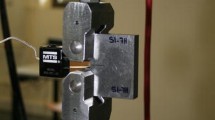Abstract
Fracture mechanics parameters of concrete are determined by means of the compact tension (CT) test. The effects of ligament length, rate of loading and concrete composition on the specific fracture energy GF and the strain-softening diagram are investigated. As a first approximation of the real softening behaviour of concrete, a bilinear strain softening diagram is used in a finite-element analysis. A parameter study shows that several bilinear diagrams can represent the real behaviour equally well. With the bilinear softening diagram, a good agreement between both calculated and measured load-displacement curves and GF-values is obtained. The determined strain-softening diagrams are transformed into a normalized presentation. For each investigated testing condition, characteristics shapes of this normalized strain-softening diagram are obtained.
Similar content being viewed by others
References
Hillerborg, A.,A Model for Fracture Analysis, Report TVBM-3005 (Division of Building Materials, Lund Institute of Technology, Sweden, 1978).
Idem,, ‘Analysis of one single crack’, inFracture Mechanics of Concrete, edited by F. H. Wittmann (Elsevier, Amsterdam 1983), pp. 223–249.
Bazant, Z.P. and Oh, B.H., ‘Crack band theory for fracture of concrete,’Mater. Struct. 16, (1983). 155–177.
RILEM Draft Recommendation 50-FMC, ‘Determination of fracture energy of mortar and concrete by means of three-point bend tests on notched beams’,ibid.,18 (1985) 285–290.
Roelfstra, P.E. and Wittmann, F.H., ‘Numercial method to link strain softening with failure of concrete’, inFracture Toughness and Fracture Energy of Concrete, edited by F.H. Wittmann (Elsevier, Amsterdam 1986) pp. 163–175.
Rots, J.G., ‘Strain-softening analysis of concrete fracture specimens’, inFracture Toughness and Fracture Energy of Concrete, edited by F.H. Wittmann (Elsevier, Amsterdam 1986) pp. 137–148.
Petersson, P.E.,Crack Growth and Development of Fracture Zones in Plain Concrete and Similar Materials, Report TVBM-1001 (Division of Building Materials, Lund Institute of Technology, Sweden, 1981).
Cornelissen, H.A.W., Hordijk, D.A. and Reinhardt, H.W., ‘Experiments and theory for application of fracture mechanics to normal and lightweight concrete’, inFracture Toughness and Fracture Energy of Concrete, edited by F.H. Wittmann (Elsevier, Amsterdam 1986) pp. 565–575.
Alvaredo, A.M. and Torrent, R.J., ‘The effect of the shape of the strain-softening diagram on the bearing capacity of concrete beams’,Mater. Struct. in press.
Hillerborg, A., ‘The theoretical basis of a method to determine the fracture energyG F of concrete’,ibid 18 (106) (1985) 291–296.
Roelfstra, P.E. and Sadouki, H.,Fracture I, Theory and Applications (Laboratory for Buildings Materials, Swiss Federal Institute of Technology, Lausanne, 1987).
Wittmann, F.H., Huang, Y., Roelfstra, P.E., Mihashi, H., Nomura, N. and Zhang, X., ‘Influence of age of loading, water-cement ratio and rate of loading on fracture energy of concrete’,Mater. Struct. 20 (1987) 103–110.
Brühwiler, E., Rokugo, K. and Wittmann, F.H., ‘Influence of rate of loading on fracture energy and strain softening’,SMIRT-9 Transactions, Vol. H, Balkema, Rotterdam pp. 25–23.
Kleinschrodt, H.D. and Winkler, H., ‘The influence of the maximum aggregate size and the size of the specimen on fracture mechanics parameters’, inFracture Toughness and Fracture Energy of Concrete, edited by F.H. Wittman (Elsevier, 1986) pp. 391–402.
Petersson, P.E., ‘Fracture energy of concrete: practical performance and experimental results’,Cement and Concrete research 10 (1980) 91–101.
Author information
Authors and Affiliations
Rights and permissions
About this article
Cite this article
Wittmann, F.H., Rokugo, K., Brühwiler, E. et al. Fracture energy and strain softening of concrete as determined by means of compact tension specimens. Materials and Structures 21, 21–32 (1988). https://doi.org/10.1007/BF02472525
Issue Date:
DOI: https://doi.org/10.1007/BF02472525




